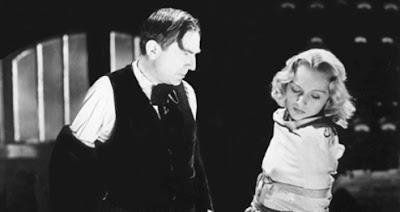Format: Streaming video from Tubi TV on Fire!

I spend a little time each month researching where I can find movies on my various lists. A lot of the really early movies are harder to find. Services like NetFlix and Amazon Prime, and even the free film libraries like Tubi and Pluto don’t have a lot of the weirder films pre-1940. I discovered that The Dark Eyes of London was playing on Tubi and I figured I’d give it a watch. Then I couldn’t find it; I didn’t realize that it had also been released under the more prurient but far less evocative name The Human Monster.
The original title is a much more interesting one, because in this case, the “dark eyes” refer to a collection of men who are blind. We’re not going to start here, though; we’re going to start with the recovery of a drowned body in the Thames. There’s been a rash of such bodies we learn, and the police seem to be unable to find any leads because, well, this is a movie. Finally, someone comes up with the brilliant idea of seeing who held the insurance policies on those corpses, and it turns out that all of them were insured by a guy named Dr. Orloff (Bela Lugosi), who runs a very small insurance business and who spends most of his time on charity work with the blind. It just so happens that this home for the blind is right along the Thames, because of course it is.
The scheme, which we learn of pretty quickly, is that Orloff gets someone who has no known relatives to essentially make him or the house for the blind their beneficiary. Then, when he gives them a tour of the place, he has a blind thug named Jake (Wilfred Walter) bump them off. The victims are drowned and then dumped into the Thames where they are soon discovered by the police. Naturally, the police in the form of Detective Inspector Larry Holt (Hugh Williams) immediately suspect that Orloff is fishy. All of the dead bodies were insured by him, after all, and the money seems to be going to his charity. Holt is assisted by police lieutenant Patrick O’Reilly (Edmund Ryan) of the Chicago PD, who is in London on some sort of work exchange…or something.
Anyway, things get complicated when it turns out that Orloff’s last victim had an actual beneficiary, his daughter Diana (Greta Gynt). Orloff gets his forger out of jail, has him do a little work on the policy, and then has Jake bump him off as well because that won’t look suspicious at all. And, naturally, Diana is going to be on the list of potential victims as well because as the daughter of a murdered man, she is too connected to what is going on.
Look, The Dark Eyes of London is a silly movie. The characters are broad and that’s what we expect, since this is a step away from melodrama. We don’t really need to go beyond the presence of a character like Jake for that case to be made. Jake is the blind brute who does all of Orloff’s killing for him. He’s blind because, well, he is even though he really doesn’t have to be. What he really didn’t have to be, though, was a monster. He is a monster, though. Jake looks like a creature that would serve as one of Lugosi’s sidekicks in an Ed Wood movie. He’s got a weird mop of hair, bat ears that stick out from the sides of his head, and teeth that don’t fit inside his mouth. I’m sure in 1939 he was scary, but today, it’s just goofy. And it’s completely unnecessary. Jake could just as easily be a big guy without making him look like the son of the Wolf Man and someone who makes their living in the circus sideshow.
The Dark Eyes of London hasn’t really aged that well. It’s about what you expect for its time, but for today’s fan of thrillers and horror, there’s not a great deal here that is surprising or really even that interesting. The plot is pretty dumb because the bad guy is pretty dumb. And there’s no surprise who that bad guy is; you see Bela Lugosi in the credits, and you know he’s going to be the crazed murderer. There’s also no surprise that we’re going to have a romance blossom between Diana and our detective inspector because it wouldn’t be a movie from 1939 without it.
But it does have its moments. When we see one of the victims realize he’s about to be killed off horribly (and wrapped in a straitjacket first to prevent him from struggling), it’s a moment that almost feels like it was referenced in the classic sliding door moment in The Texas Chainsaw Massacre. There’s a true darkness to Orloff’s actions, and a menace in places that feels out of place in a 1939 film. So, while there are some real problems here, this is a movie that, especially for its time, earns its horror cred.
Why to watch The Dark Eyes of London: It’s about as disturbing as you’re going to find for 1939.
Why not to watch: Man, but criminals in these old films are really dumb.
